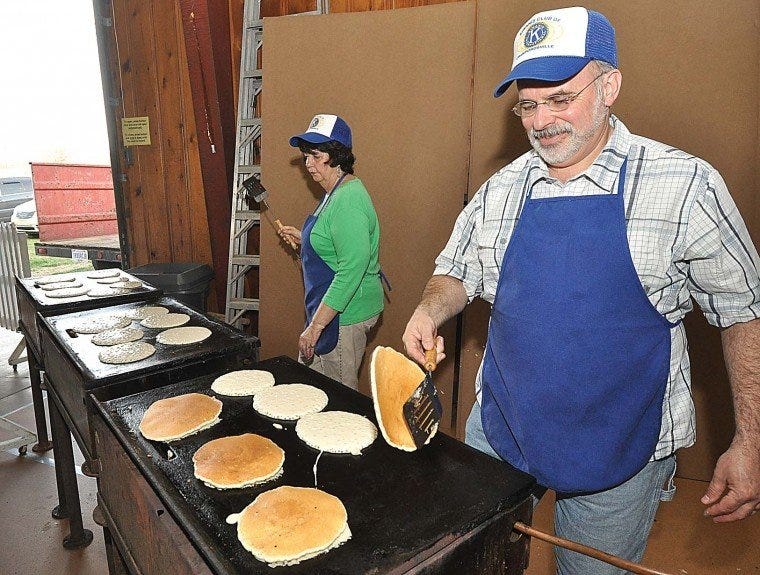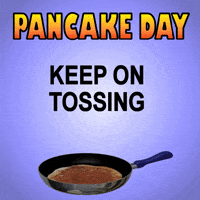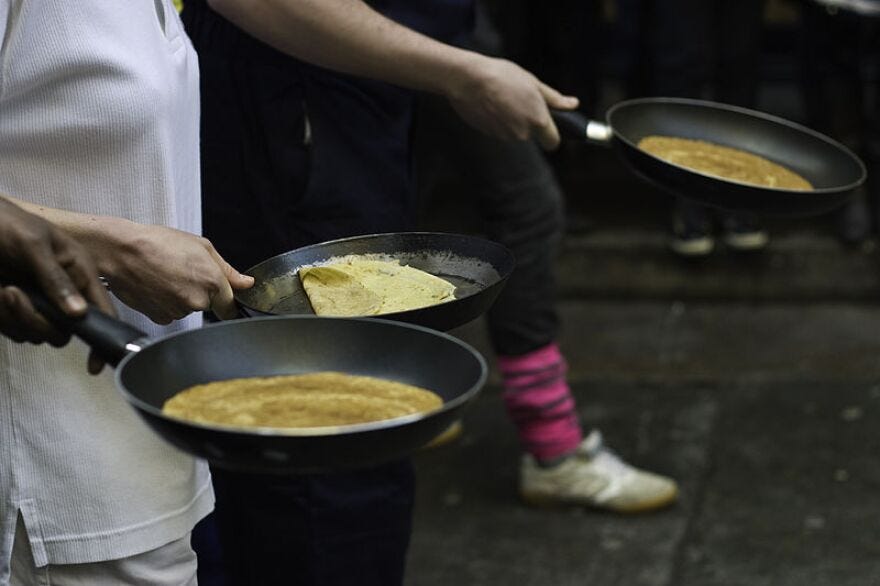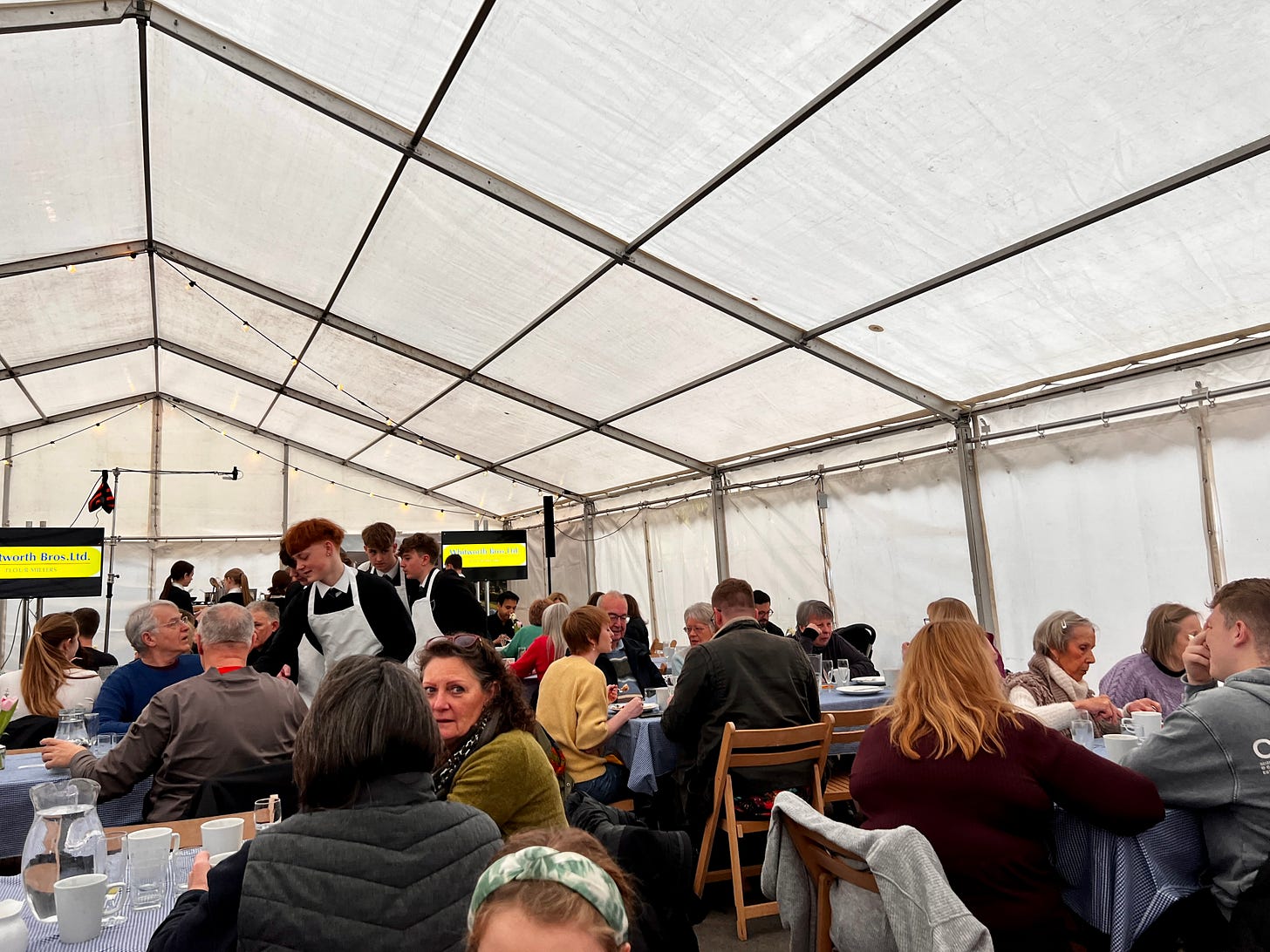Where is The Oldest Pancake Race in the World?
It's time for a Curious Minds field trip!
Hello!
When I was growing up in Small Town, Indiana, my dad used to take me to the local Kiwanis Club’s pancake fundraiser.
For five bucks, folks lined up to get all-you-can-eat pancakes, served with butter and (I’m-pretty-sure-not-real) maple syrup.
They held the pancake fundraiser at various times of the year, but often on Shrove Tuesday, the day before Lent began.
Historically, Christians would abstain from certain foods (or even fast) during Lent, and Shrove Tuesday was the last day to use up fats and eggs before Lent began.
Pancakes were the ideal food to use these ingredients.
So for many years, I have associated pancakes with Shrove Tuesday.
But the label “Pancake Day” for Shrove Tuesday came on to my radar when I moved to London in 2009.
I noticed cafés would promote “Pancake Day” on Shrove Tuesday, with some even adding pancakes to their menu just for the day.
Then I discovered London even had pancake races on Pancake Day.
But then I learned that these races were mere imitations of the “world famous” Pancake Day Race that took place in a small town in England.
A world famous pancake race?
I was curious …
With many schools on break this week, the timing was perfect.
Who needs a ski trip in Austria when you can see a *world famous* pancake race in England?
It was time for Curious Minds to take a field trip!
The family and I headed about 60 miles north of London to a town called Olney, home of the most famous pancake race in the world.
And we knew we were in the right place as soon as we saw this sign welcoming us:
So what is a Pancake Race?
It’s a running race, where contestants carry a frying pan containing a pancake.
And it happens every year on Shrove Tuesday, aka Pancake Day.
But while other places in England have pancake races, the one in Olney is special.
It dates back to 1445. (Yes, 1445!)
But how it began is somewhat of a mystery.
Legend has it that the tradition began in the 15th Century on Shrove Tuesday when a housewife in Olney was making pancakes.
She heard the “shriving bell” ringing, signalling it was time for the Shriving Service to begin at church.
She was in such a hurry that she ran to church still clutching her frying pan.
Her race to church with the pan (and pancake) still in hand created a local tradition that has continued for centuries.
But the race did not happen during World War II — and the tradition might have been lost if it hadn’t been for the the Vicar of Olney, the Reverend Ronald Collins.
While clearing out a cupboard, Reverend Collins came across some old photographs from the 1920s and 30s that showed women running with frying pans.
After seeing the photos, he called for volunteers and revived the race in 1948.
Thirteen runners competed that Shrove Tuesday.
The rules were simple.
Only women from Olney could compete, and they had to wear a skirt, an apron, and a headscarf.
They also had to carry a pan — with a pancake — for the entirety of the race.
The also had to flip their pancake at the start and end of the race.
While records don’t indicate where the Olney race originally began, today it starts outside The Bull Hotel on Market Place and finishes at Olney’s St. Peter and St. Paul Church 380 metres (or 415 yards) away.
And two years after Olney’s race was revived, it went international…
Across the Atlantic, RJ Leete, a resident of the small town of Liberal, Kansas had seen a picture of the Olney race in a magazine.
RJ wanted to bring the race to Liberal, and reached out to Reverend Collins, challenging the women of Olney to race against the women of Liberal.
After several letters, cables, and a telephone call, the first race was set for Shrove Tuesday, 1950.
Olney’s winner was 8 seconds faster than Liberal’s winner that year.
But a Transatlantic competition was born.
The race against Liberal has been going strong ever since, and 2024 celebrates 75 years of the tradition.
The bonds between the two towns have grown through a friendly competition, with residents from each town visiting the other as special guests.
RJ Leete and his wife made the trip to Olney several times to watch the race, noting the different ways the towns approached the occasion.
“In Olney it is so precisely done. So much of their Pancake Day Race is for charity.
“Liberal is more commercial,” he said.
“Here it’s a big, big deal. And there they have the race and go back to work, but return in the evening for the video call with Liberal.”
Or as one British visitor commented after visiting Liberal to watch the race:
“Leave it to the Americans to take a 15-minute race and turn it into a four-day holiday, beauty contest, and talent show.”
Liberal does have several days worth of activities, including a 5K race, a pancake flipping contest, a parade, and plenty of races for men, women, and kids.
And unsurprisingly, they even have an online store where you can buy your pancake day merch — from T-shirts and aprons to tea towels and pancake flippers.
My Olney Pancake Day experience was perhaps… more subdued.
It began with —what else?— a pancake breakfast, followed by a series of kids’ races.
My family and I watched (in the rain) as local nursery school and primary school kids donned aprons and sprinted toward the finish line, pancake pans in hand.
Then, spectators lined the route from Market Place to St. Peter and St. Paul Church, as the women participating in the race got into position.
Contestants were provided with an apron and headscarf, and a pancake pan.
But they had to bring their own pancake.
And, as much as I would have loved to join the race, it is only open to the ladies of Olney – and you have to have lived or worked in Olney for at least three months to compete.
Then with the ring of the bell at 11:55 am, they were off!
It was a photo finish, too, as Olney’s Kaisa Larkas claimed the victory with a race time of 63:37 seconds.
Some women were clearly focused on winning the race, while others seemed more focused on having fun.
Following the Olney race, the contestants and locals headed for the Shriving Service at the church, and later that evening, the two towns connected online to compare times and award prizes.
Liberal took the victory this year - just - as their top racer Pamela Bolivar finished the race with a time of 63:03 seconds.
And while it might be a short race and a friendly competition, it means more to the people involved.
“It’s not just a race,” said Ruth Martin, a member of the Olney pancake race committee.
“There's something so quintessentially Olney about it. Everyone will just pause in the middle of the day, literally stopping the traffic.
“We have a super community here. Everyone just comes together for that moment.”
Pics or it didn’t happen…
See if you can spot me (and my kids!) in this AP story about the 2024 race!
(Note: I am not the woman dressed in period costume.)
Still curious?
Check out this video from Olney:
And here’s footage from the 2023 race in Liberal, Kansas:
Not one - but TWO - more things…
The pancake race is not the only thing noteworthy about these two towns.
Olney is also the birthplace of the song Amazing Grace, written by John Newton.
Newton wrote the words of Amazing Grace for a sermon called Faith’s Review and Expectation in 1773 — and had I visited in 2023, I could have been there for the 250th anniversary celebrations.
Newton collaborated with poet William Cowper on the Olney Hymns (published in 1779), which include the sermon’s words as Amazing Race.
I learned all about them from the lovely volunteers at the Cowper & Newton Museum (worth a visit if you’re in town!).
Liberal has a different claim to fame — Dorothy from The Wizard of Oz.
Bet you didn’t know Dorothy was from Liberal!
Well, technically, she wasn’t…
But in the 1970s, local resident Max Zimmerman realized no city in Kansas had claimed Dorothy — and he saw an opportunity for Liberal.
Visitors to Liberal can enjoy “an immersive Wizard of Oz Tour that combines a colorful recreation of the film with stories of actual life on a 1900s farmhouse.”
Plan your visit to Olney or Liberal for next March and you can enjoy your pancakes with your history lessons!
What Else Is On My Mind?
Enough of the Ghosting — It may be more common these days, but that doesn’t mean it’s OK.
Communication Wonders & Blunders — Find out which communication moments from CEOs, politicians, entertainers, and companies caught my attention in January — and what we can learn from them.
Remember when a smoking camel was scary? I do, and I’d take Joe any day over what I read is happening to CHILDREN on the platforms owned by Meta.
How Can I Help?
I’ll keep saying it: Communication matters.
If you want to improve your communication (and get all the good things that come with that), I’m your gal.
So many companies could reap massive rewards – from performance and culture to retention and engagement – by improving their communication.
So, if you know someone who could benefit from some help (as even the most seasoned leaders do), please get in touch and check out my website for more information.
You can also see my Top 10 list of what I can (and can’t) do for you here.
And if you see any communication examples (the good, the bad, and the ugly) that you think are worth analyzing or sharing, please send them my way!
Stay Curious!
-Beth






























Here in Arizona, we have the annual 5K/10K Pancake Race, so named for its pancake-flat course. Pancakes are served post-race, but no skillets on the course...yet